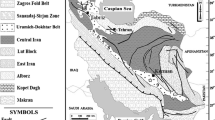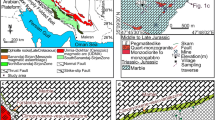Abstract.
At Salanfe (Aiguilles Rouges Massif, Swiss Alps) several stratabound W–Au–As-skarn bodies were formed at the contact between pre-Ordovician marble lenses and paragneiss in close proximity to an anatectic leucogranite of Late Palaeozoic age. Anatexis and leucogranite formation occurred at peak metamorphic conditions of P=0.45 GPa and T~650–700 °C. This metamorphic event, dated at 317 Ma in the adjacent Mont Blanc Massif, was related to dextral transpression following continental collision. Structural evidence indicates that the initial stages of skarn formation also occurred under the above P–T conditions. The main stratiform skarn body (Robert) consists of a massive facies close to the marble and of a banded facies on the paragneiss side. The massive facies resulted from the replacement of former dolomite marble, whereas the banded facies resulted mostly from the replacement of thin carbonate layers intercalated in the paragneiss. In the massive facies, the prograde stage skarn is composed by hedenbergite with increasing Fe concentrations through skarn evolutionary stages, whereas in the banded facies it consists of diopside–plagioclase–quartz. The imprint of the retrograde stage is minor and unevenly distributed, with replacement of the pyroxene by magnetite/haematite–calcite–quartz close to the marble and by chlorite–epidote close to the paragneiss. The economic ore minerals are scheelite, arsenopyrite, loellingite and gold and are mainly associated with the prograde skarn stage. Most of the scheelite mineralization occurs during the early prograde stage, probably at temperatures higher than 600 °C, and is associated with pyroxene (hedenbergite 55). Arsenopyrite and loellingite precipitated after scheelite at temperatures between 600 and 350 °C and are associated with hedenbergite>80. Gold occurs both in the final prograde stage and in the retrograde stage. Minor second generation scheelite is associated with epidote and chlorite of the retrograde stage. Lead isotopes indicate that skarn ore minerals were precipitated by a low Th/U fluid like that in equilibrium with the anatectic leucogranite. Oxygen isotopes support the contention that the prograde skarn was formed by a fluid in equilibrium with the leucogranite, mixed with increasing amounts of CO2 approaching the skarn–marble contact. Oxygen and hydrogen isotopes suggest the intervention of a non-magmatic fluid (meteoric, connate?) during the retrograde stage. The Salanfe skarns were formed at deep crustal levels by fluids in equilibrium with an anatectic leucogranite, possibly channelled along permeable paragneiss during regional-scale transpression, and could be the deep expression of a widespread W–Au hydrothermal ore event that occurred along the European Variscides at 310–305 Ma.
Similar content being viewed by others
Author information
Authors and Affiliations
Additional information
Electronic Publication
Rights and permissions
About this article
Cite this article
Chiaradia, M. Formation and evolution processes of the Salanfe W–Au–As-skarns (Aiguilles Rouges Massif, western Swiss Alps). Miner Deposita 38, 154–168 (2003). https://doi.org/10.1007/s00126-002-0296-1
Received:
Accepted:
Issue Date:
DOI: https://doi.org/10.1007/s00126-002-0296-1




